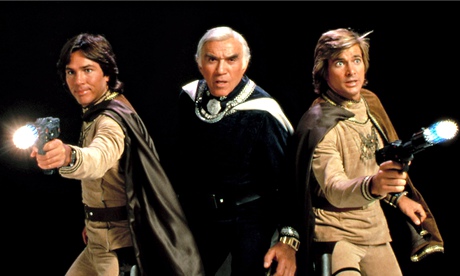
Humankind has spread across 12 planets somewhere in the deep reaches of outer space, but it’s fighting a long-running war against the Cylons, robotic beings that look part Darth Vader, part Roman centurion. When the dastardly Cylons wipe nearly everyone out, a few thousand survivors go on the run in a ragtag fleet of battered spaceships under the protection of the mighty Battlestar Galactica, a sort of spacebound aircraft carrier.
And so they embark on a search for The 13th Colony: a largely forgotten and possibly mythical little planet known as Earth.
When it appeared in the 1970s, Battlestar Galactica was the most expensive TV show ever, costing a (then) whopping $7m. It was a lavish affair with huge sets and a charming cast headed by Lorne Greene, star of the western series Bonanza. He was assisted by good-looking younger leads like Jane Seymour as news reporter Serina and Dirk Benedict (Faceman from The A-Team) as hotshot fighter pilot Starbuck – although it wasn’t unknown for Hollywood legends to pop up as guests. Fred Astaire even makes an appearance at one point, as a space conman who may or may not be Starbuck’s father.
There was always plenty of action, often in the form of blazing dogfights with Cylon ships. And, thanks to special effects superstar John Dykstra, the models and the opticals are top-notch, Dykstra refining many of the groundbreaking techniques he introduced while working on Star Wars. Producer/creator Glen Larson was raised a Mormon and knew how well the theme of the quest for a promised land could work on screen, especially if mixed with a bit of science. For Battlestar, he pilfered from anywhere and everywhere, as most shows did back then. One adventure riffs on the plot of The Guns of Navarone with a bit of The Dirty Dozen thrown in (a race of clones appears too, the females all played by Britt Ekland). Another episode leans so heavily on High Noon and Shane that some characters actually wear silver cowboy hats. Adults could enjoy spotting the similarities, while children had fun seeing these road-tested stories as new and often mind-blowing.
Stopping off to refuel and resupply brings these space pilgrims into contact with other worlds, many of them locked in political turmoil or undergoing Cylon occupation; one planet they visit serves as a giant penal colony. Echoing many shows of the era, from The A-Team to The Incredible Hulk, this leads to some standard “helping out a town in trouble” fare – just swap “town” for “planet”. But some adventures, especially the ones that stretch across two episodes, are utterly gripping. In War of the Gods, Patrick Macnee plays the sole survivor of a crashed spaceship, an enigmatic character who seems able to use mind power to move objects and make food grow. He charms his way into leading the fleet before being exposed as an outer space version of the devil, complete with his own fallen-angel backstory.
Even through the feelgood lens of mainstream American TV and the general disco-era gaudiness (there’s a Supremes-like trio, each singer boasting four eyes and two mouths), plenty of grit comes through. This is, after all, a story of genocide and survival – something the wonderfully grim and gloomy 2004 remake exploited to the full. But the makers did manage to sneak a few things past the censors: Battlestar’s futuristic lingo features the masterful space swear word “frack”, which made it to other sci-fi shows and literature.
Larson knew what movies could be turned into monster TV hits: he was the brains behind Alias Smith & Jones, the small-screen version of Butch Cassidy and the Sundance Kid. But Battlestar was arguably his biggest achievement, essentially the TV version of Star Wars. Larson moved fast to acquire some of the key talents associated with George Lucas’s film, knocking his own series out within a year of its arrival. For the most part, it’s still fracking spectacular.







